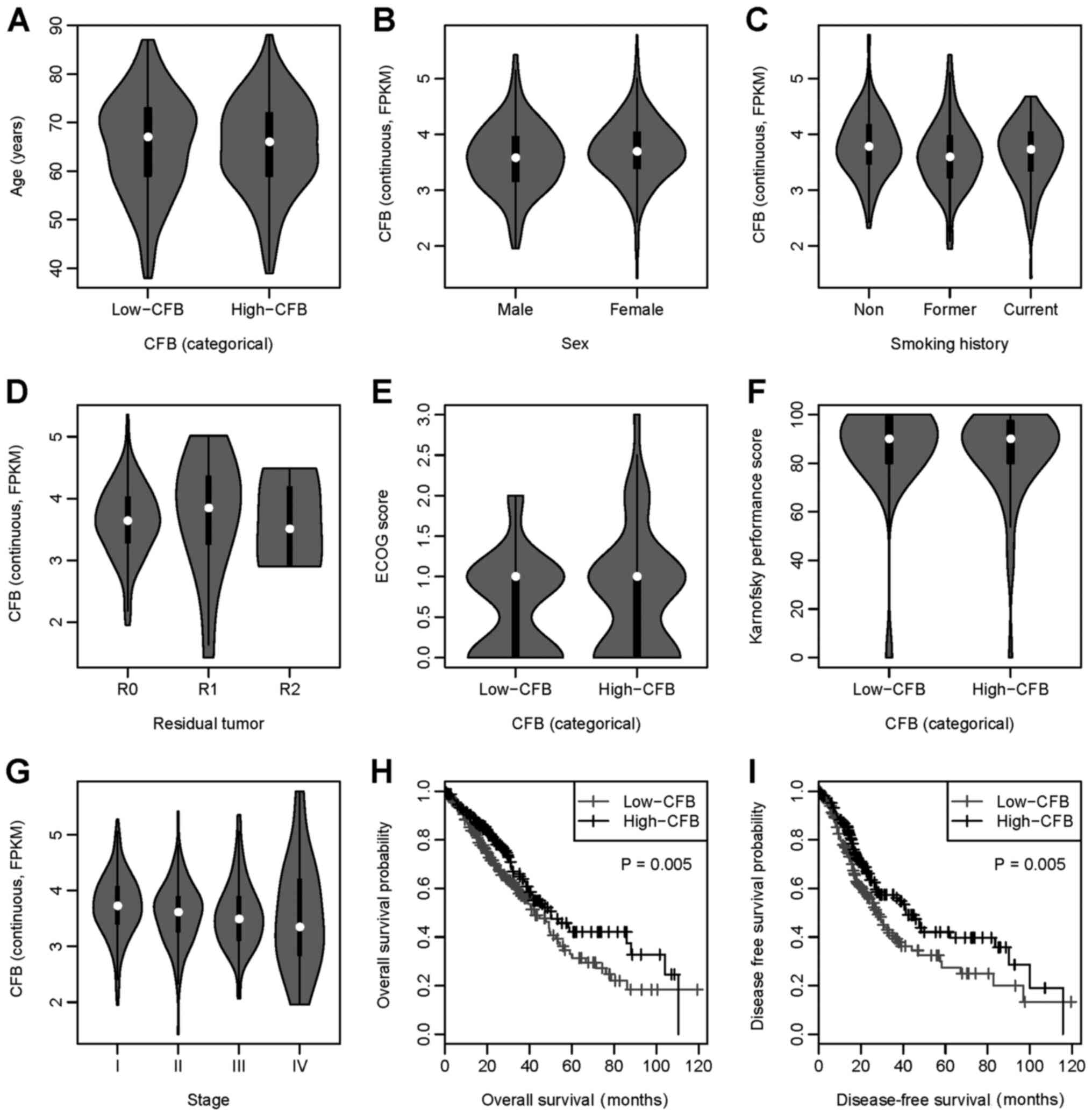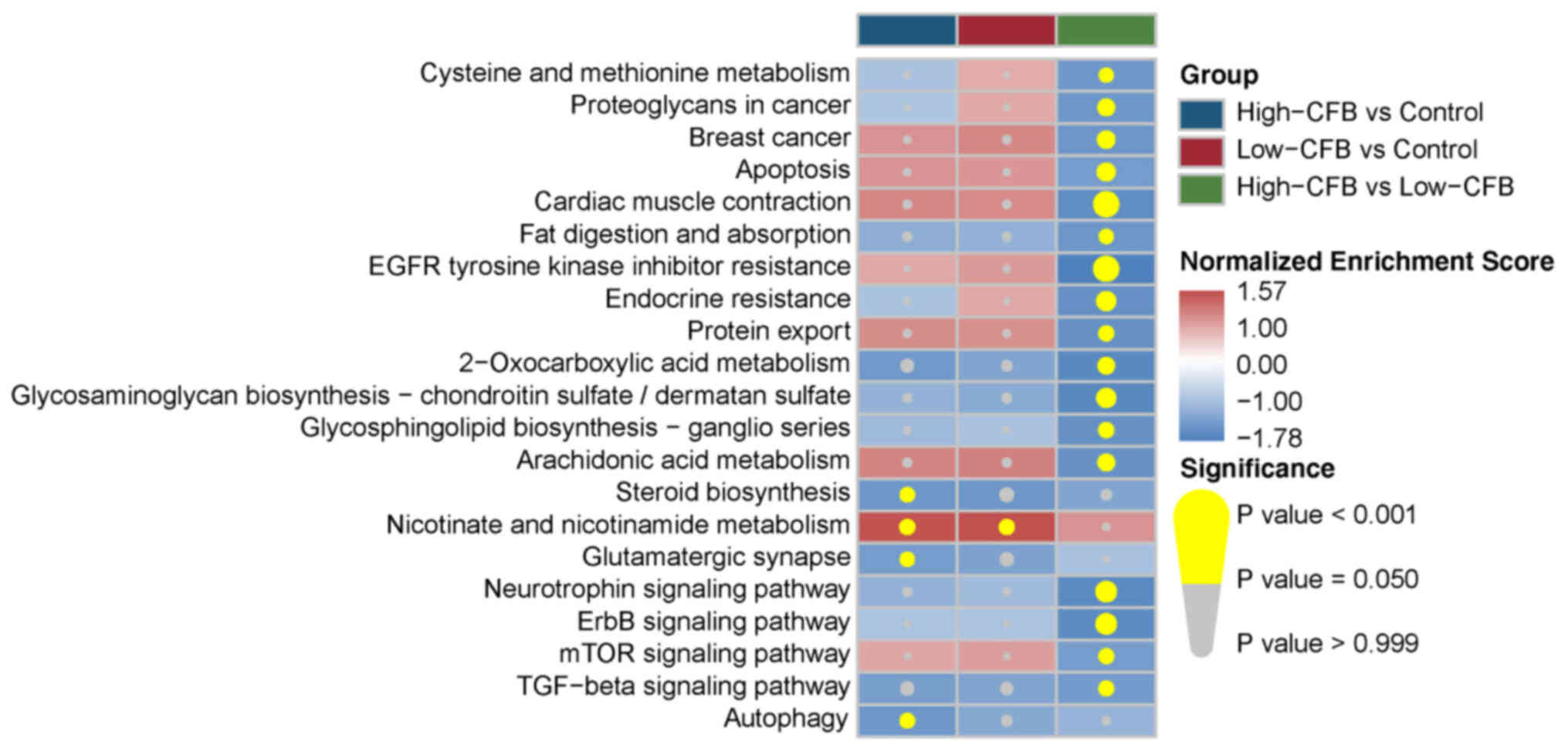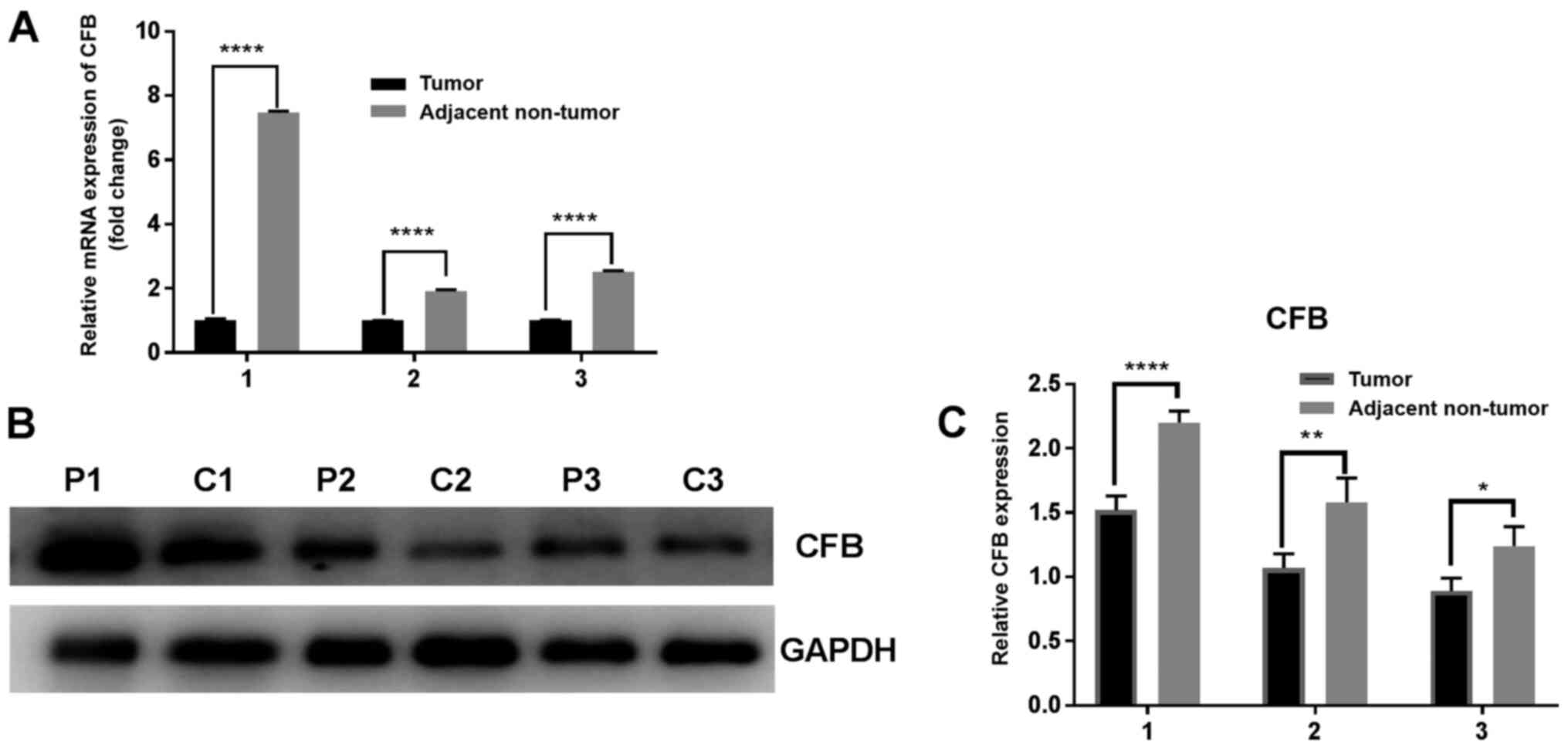|
1
|
Siegel RL, Miller KD and Jemal A: Cancer
statistics, 2019. CA Cancer J Clin. 69:7–34. 2019. View Article : Google Scholar : PubMed/NCBI
|
|
2
|
Jackman DM and Johnson BE: Small-cell lung
cancer. Lancet. 366:1385–1396. 2005. View Article : Google Scholar : PubMed/NCBI
|
|
3
|
Li C and Lu H: Adenosquamous carcinoma of
the lung. OncoTargets Ther. 11:4829–4835. 2018. View Article : Google Scholar : PubMed/NCBI
|
|
4
|
Scheff RJ and Schneider BJ: Non-small-cell
lung cancer: treatment of late stage disease: chemotherapeutics and
new frontiers. Semin Intervent Radiol. 30:191–198. 2013. View Article : Google Scholar : PubMed/NCBI
|
|
5
|
Yu HA, Paz-Ares LG, Yang JC, Lee KH,
Garrido P, Park K, Kim JH, Lee DH, Mao H, Wijayawardana SR, et al:
Phase I study of the efficacy and safety of ramucirumab in
combination with osimertinib in advanced T790M-positive EGFR-mutant
non-small cell lung cancer. Clin Cancer Res. 27:992–1002. 2021.
View Article : Google Scholar : PubMed/NCBI
|
|
6
|
Liu Y, Gao GF, Minna JD, Williams NS and
Westover KD: Loss of wild type KRAS in KRASMUT lung adenocarcinoma
is associated with cancer mortality and confers sensitivity to FASN
inhibitors. Lung Cancer. 153:73–80. 2021. View Article : Google Scholar : PubMed/NCBI
|
|
7
|
Denisenko TV, Budkevich IN and Zhivotovsky
B: Cell death-based treatment of lung adenocarcinoma. Cell Death
Dis. 9:1172018. View Article : Google Scholar : PubMed/NCBI
|
|
8
|
Rutkowski MJ, Sughrue ME, Kane AJ, Mills
SA and Parsa AT: Cancer and the complement cascade. Mol Cancer Res.
8:1453–1465. 2010. View Article : Google Scholar : PubMed/NCBI
|
|
9
|
Gros P, Milder FJ and Janssen BJ:
Complement driven by conformational changes. Nat Rev Immunol.
8:48–58. 2008. View
Article : Google Scholar : PubMed/NCBI
|
|
10
|
Kleczko EK, Kwak JW, Schenk EL and
Nemenoff RA: Targeting the complement pathway as a therapeutic
strategy in lung cancer. Front Immunol. 10:9542019. View Article : Google Scholar : PubMed/NCBI
|
|
11
|
Walport MJ: Complement. First of two
parts. N Engl J Med. 344:1058–1066. 2001. View Article : Google Scholar : PubMed/NCBI
|
|
12
|
Walport MJ: Complement. Second of two
parts. N Engl J Med. 344:1140–1144. 2001. View Article : Google Scholar : PubMed/NCBI
|
|
13
|
Lee MJ, Na K, Jeong SK, Lim JS, Kim SA,
Lee MJ, Song SY, Kim H, Hancock WS and Paik YK: Identification of
human complement factor B as a novel biomarker candidate for
pancreatic ductal adenocarcinoma. J Proteome Res. 13:4878–4888.
2014. View Article : Google Scholar : PubMed/NCBI
|
|
14
|
Low HP, Tiwari A, Janjanam J, Qiu L, Chang
CI, Strohsnitter WC, Norwitz ER, Tam SW, Evans JE, Green KM, et al:
Screening preeclamptic cord plasma for proteins associated with
decreased breast cancer susceptibility. Genomics Proteomics
Bioinformatics. 11:335–344. 2013. View Article : Google Scholar : PubMed/NCBI
|
|
15
|
Byrne SN, Hammond KJ, Chan CY, Rogers LJ,
Beaugie C, Rana S, Marsh-Wakefield F, Thurman JM and Halliday GM:
The alternative complement component factor B regulates UV-induced
oedema, systemic suppression of contact and delayed
hypersensitivity, and mast cell infiltration into the skin.
Photochem Photobiol Sci. 14:801–806. 2015. View Article : Google Scholar : PubMed/NCBI
|
|
16
|
Andoh A, Fujiyama Y, Sakumoto H, Uchihara
H, Kimura T, Koyama S and Bamba T: Detection of complement C3 and
factor B gene expression in normal colorectal mucosa, adenomas and
carcinomas. Clin Exp Immunol. 111:477–483. 1998. View Article : Google Scholar : PubMed/NCBI
|
|
17
|
Suman S, Basak T, Gupta P, Mishra S, Kumar
V, Sengupta S and Shukla Y: Corrigendum to ‘Quantitative proteomics
revealed novel proteins associated with molecular subtypes of
breast cancer’ [Journal of Proteomics 148, (2016) 183–193]. J
Proteomics. 208:1035072019. View Article : Google Scholar : PubMed/NCBI
|
|
18
|
Kwak JW, Laskowski J, Li HY, McSharry MV,
Sippel TR, Bullock BL, Johnson AM, Poczobutt JM, Neuwelt AJ,
Malkoski SP, et al: Complement Activation via a C3a Receptor
Pathway Alters CD4+ T Lymphocytes and Mediates Lung Cancer
Progression. Cancer Res. 78:143–156. 2018. View Article : Google Scholar : PubMed/NCBI
|
|
19
|
Azam F, Latif MF, Farooq A, Tirmazy SH,
AlShahrani S, Bashir S and Bukhari N: Performance status assessment
by using ECOG (Eastern Cooperative Oncology Group) score for cancer
patients by oncology healthcare professionals. Case Rep Oncol.
12:728–736. 2019. View Article : Google Scholar : PubMed/NCBI
|
|
20
|
Barbetta C, Allgar V, Maddocks M, Ribeiro
C, Wilcock A, Currow DC, Phillips J and Johnson MJ:
Australia-modified Karnofsky Performance Scale and physical
activity in COPD and lung cancer: an exploratory pooled data
analysis. BMJ Support Palliat Care. Jun 11–2019.(Epub ahead of
print). doi: 10.1136/bmjspcare-2019-001869. View Article : Google Scholar : PubMed/NCBI
|
|
21
|
Woodard GA, Jones KD and Jablons DM: Lung
Cancer Staging and Prognosis. Cancer Treat Res. 170:47–75. 2016.
View Article : Google Scholar : PubMed/NCBI
|
|
22
|
Wishart DS: Emerging applications of
metabolomics in drug discovery and precision medicine. Nat Rev Drug
Discov. 15:473–484. 2016. View Article : Google Scholar : PubMed/NCBI
|
|
23
|
Livak KJ and Schmittgen TD: Analysis of
relative gene expression data using real-time quantitative PCR and
the 2(−ΔΔC(T)) method. Methods. 25:402–408. 2001. View Article : Google Scholar : PubMed/NCBI
|
|
24
|
Gold B, Merriam JE, Zernant J, Hancox LS,
Taiber AJ, Gehrs K, Cramer K, Neel J, Bergeron J, Barile GR, et al
AMD Genetics Clinical Study Group, : Variation in factor B (BF) and
complement component 2 (C2) genes is associated with age-related
macular degeneration. Nat Genet. 38:458–462. 2006. View Article : Google Scholar : PubMed/NCBI
|
|
25
|
Colten HR: Biosynthesis of the MHC-linked
complement proteins (C2, C4 and factor B) by mononuclear
phagocytes. Mol Immunol. 19:1279–1285. 1982. View Article : Google Scholar : PubMed/NCBI
|
|
26
|
Canavese F, Botnari A, Andreacchio A,
Marengo L, Samba A, Dimeglio A, Pereira B, Mansour M and Rousset M:
Displaced tibial shaft fractures with intact fibula in children:
Nonoperative management versus operative treatment with elastic
stable intramedullary nailing. J Pediatr Orthop. 36:667–672. 2016.
View Article : Google Scholar : PubMed/NCBI
|
|
27
|
Chen M, Muckersie E, Robertson M,
Forrester JV and Xu H: Up-regulation of complement factor B in
retinal pigment epithelial cells is accompanied by complement
activation in the aged retina. Exp Eye Res. 87:543–550. 2008.
View Article : Google Scholar : PubMed/NCBI
|
|
28
|
Ostvik AE, Granlund A, Gustafsson BI, Torp
SH, Espevik T, Mollnes TE, Damås JK and Sandvik AK: Mucosal
toll-like receptor 3-dependent synthesis of complement factor B and
systemic complement activation in inflammatory bowel disease.
Inflamm Bowel Dis. 20:995–1003. 2014.PubMed/NCBI
|
|
29
|
Potter BJ, Brown DJ, Watson A and Jewell
DP: Complement inhibitors and immunoconglutinins in ulcerative
colitis and Crohn's disease. Gut. 21:1030–1034. 1980. View Article : Google Scholar : PubMed/NCBI
|
|
30
|
Jiang DK, Ma XP, Yu H, Cao G, Ding DL,
Chen H, Huang HX, Gao YZ, Wu XP, Long XD, et al: Genetic variants
in five novel loci including CFB and CD40 predispose to chronic
hepatitis B. Hepatology. 62:118–128. 2015. View Article : Google Scholar : PubMed/NCBI
|
|
31
|
Ciriello G, Gatza ML, Beck AH, Wilkerson
MD, Rhie SK, Pastore A, Zhang H, McLellan M, Yau C, Kandoth C, et
al TCGA Research Network, : Comprehensive molecular portraits of
invasive lobular breast cancer. Cell. 163:506–519. 2015. View Article : Google Scholar : PubMed/NCBI
|
|
32
|
Kim SH, Lee MJ, Hwang HK, Lee SH, Kim H,
Paik YK and Kang CM: Prognostic potential of the preoperative
plasma complement factor B in resected pancreatic cancer: A pilot
study. Cancer Biomark. 24:335–342. 2019. View Article : Google Scholar : PubMed/NCBI
|
|
33
|
Lim LY, Tan GH, Zainuddin ZM, Fam XI, Goh
EH, Syaris OS, Yahaya A and Singam P: Prospective evaluation of
using multiparametric magnetic resonance imaging in cognitive
fusion prostate biopsy compared to the standard systematic 12-core
biopsy in the detection of prostate cancer. Urol Ann. 12:276–282.
2020. View Article : Google Scholar : PubMed/NCBI
|
|
34
|
Bauer D, Mazzio E, Hilliard A, Oriaku ET
and Soliman KF: Effect of apigenin on whole transcriptome profile
of TNFα-activated MDA-MB-468 triple negative breast cancer cells.
Oncol Lett. 19:2123–2132. 2020.PubMed/NCBI
|

















